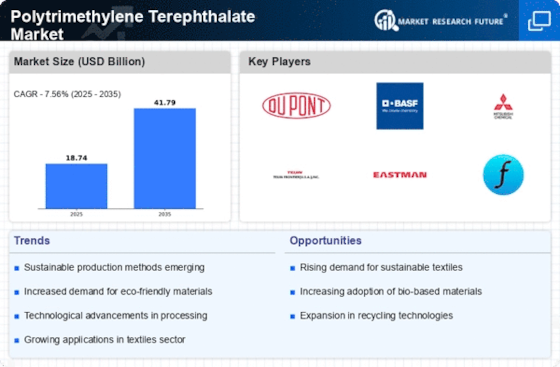Rising Demand in Textiles
The textile sector is experiencing a notable increase in the adoption of Polytrimethylene Terephthalate, significantly impacting the Polytrimethylene Terephthalate Market. This polymer is favored for its excellent durability, moisture-wicking properties, and resistance to wrinkling, making it ideal for various textile applications. Market data suggests that the demand for Polytrimethylene Terephthalate in the textile industry is projected to grow at a compound annual growth rate of over 5% through the next few years. As fashion brands increasingly seek sustainable and high-performance materials, the versatility of Polytrimethylene Terephthalate positions it as a preferred choice, further driving market expansion.
Technological Innovations
Technological advancements play a crucial role in shaping the Polytrimethylene Terephthalate Market. Innovations in production processes, such as improved polymerization techniques, have led to enhanced material properties and reduced production costs. For instance, recent developments in enzymatic recycling methods are expected to revolutionize the recycling of Polytrimethylene Terephthalate, making it more efficient and cost-effective. This could potentially increase the market's appeal to manufacturers seeking to optimize their supply chains. Furthermore, the integration of smart technologies in manufacturing processes is likely to enhance product quality and consistency, thereby driving demand in various applications.
Sustainability Initiatives
The increasing emphasis on sustainability is a pivotal driver for the Polytrimethylene Terephthalate Market. As consumers and manufacturers alike prioritize eco-friendly materials, the demand for sustainable alternatives to traditional plastics is surging. Polytrimethylene Terephthalate, being derived from renewable resources, aligns well with these sustainability goals. In recent years, the market has witnessed a notable shift, with projections indicating that the consumption of bio-based polymers, including Polytrimethylene Terephthalate, could reach significant volumes by 2026. This trend is further supported by regulatory frameworks that encourage the use of sustainable materials, thereby enhancing the market's growth potential.
Growth in Packaging Applications
The packaging industry is witnessing a significant transformation, with Polytrimethylene Terephthalate emerging as a key material in this sector. The Polytrimethylene Terephthalate Market is benefiting from the rising demand for lightweight, durable, and recyclable packaging solutions. As consumers become more environmentally conscious, brands are shifting towards sustainable packaging options, which Polytrimethylene Terephthalate readily provides. Recent market analyses indicate that the use of this polymer in packaging applications is expected to grow substantially, driven by its ability to reduce carbon footprints and enhance product shelf life. This trend is likely to bolster the market's growth trajectory in the coming years.
Regulatory Support for Eco-Friendly Materials
Regulatory frameworks promoting the use of eco-friendly materials are significantly influencing the Polytrimethylene Terephthalate Market. Governments worldwide are implementing policies aimed at reducing plastic waste and encouraging the adoption of sustainable alternatives. These regulations are likely to create a favorable environment for the growth of Polytrimethylene Terephthalate, as it is recognized for its lower environmental impact compared to conventional plastics. Market forecasts suggest that as these regulations become more stringent, the demand for Polytrimethylene Terephthalate will likely increase, positioning it as a viable solution for manufacturers seeking compliance while meeting consumer expectations for sustainability.

















Leave a Comment